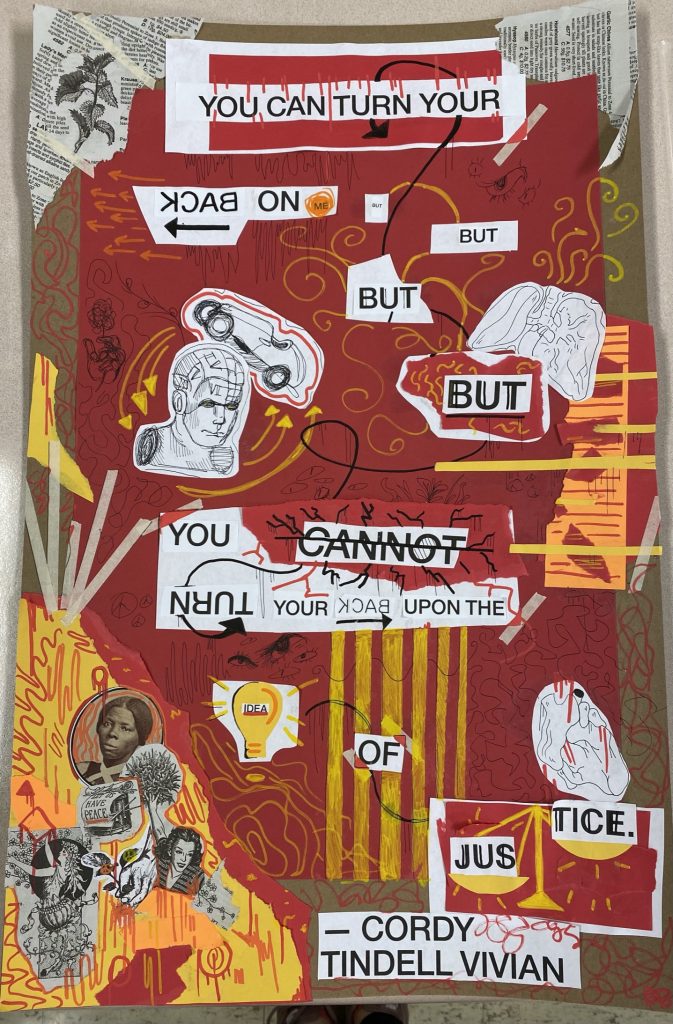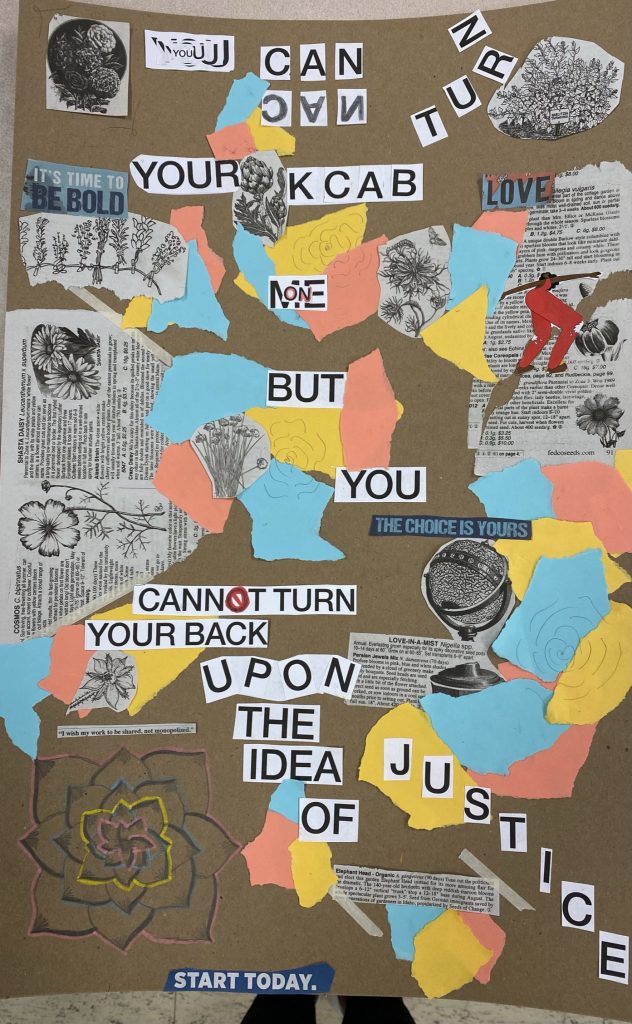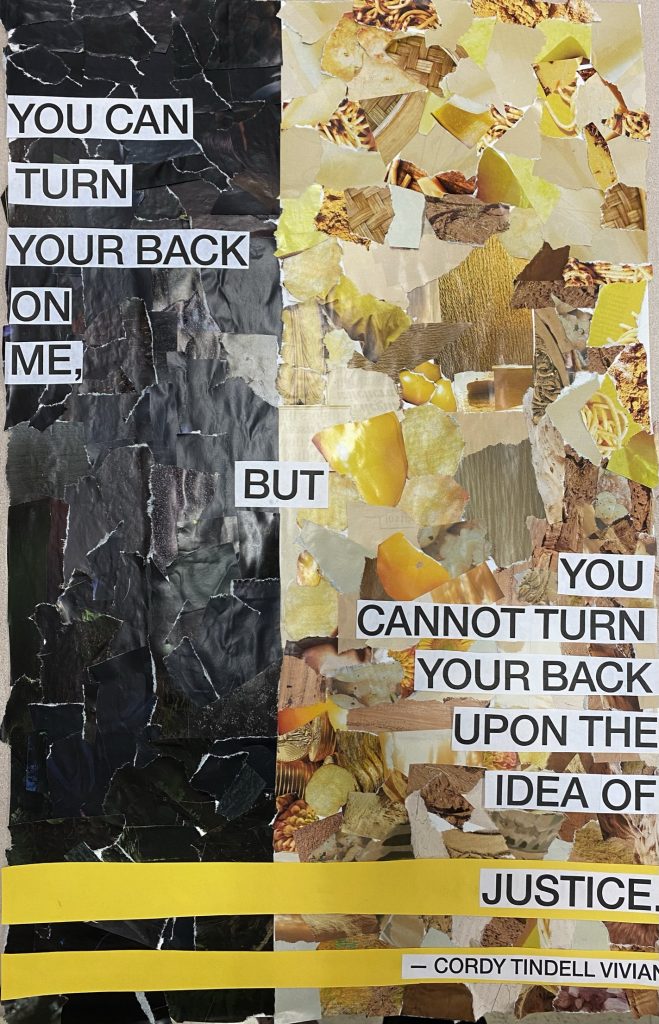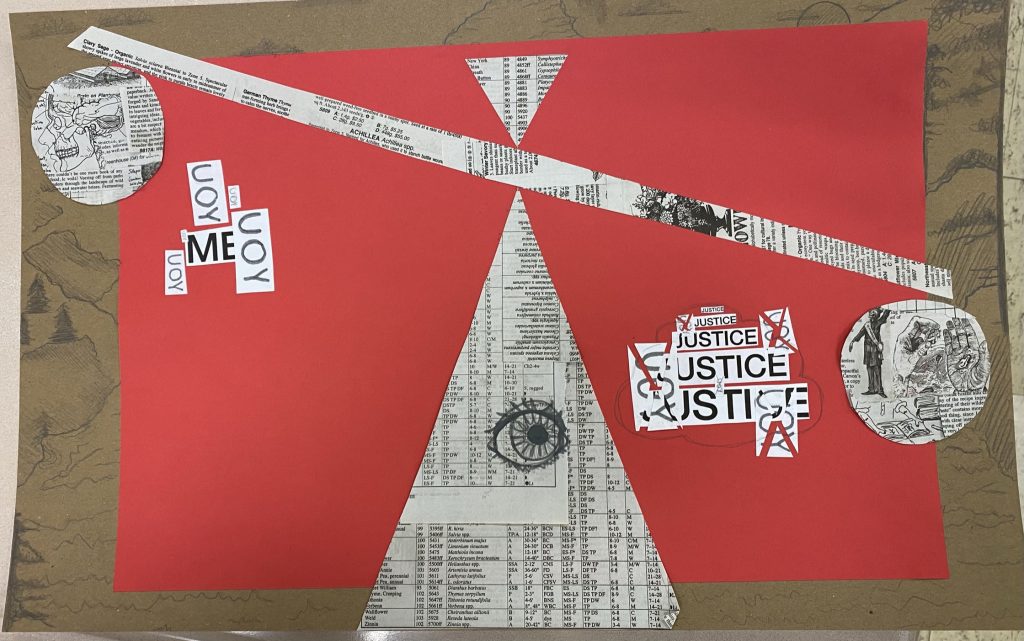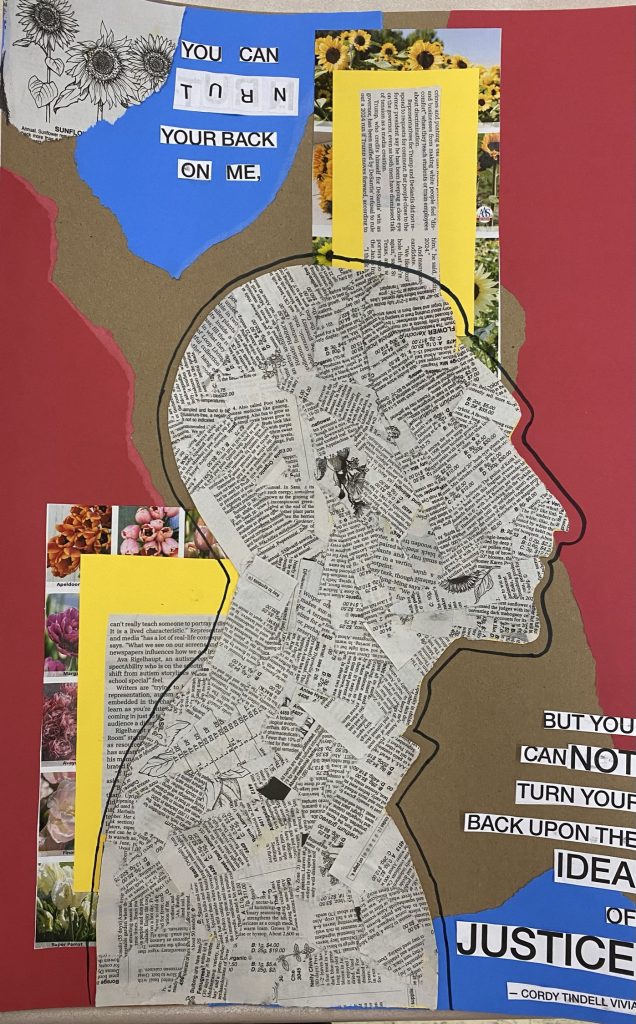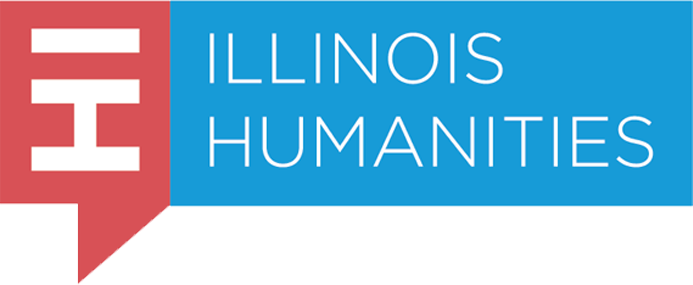The Macomb High School Studio Arts Students participated in a day-long workshop, presented by the Design Museum of Chicago’s Founder and Executive Director, Tanner Woodford, and Executive Director of Programming and Operations, Kevin Reader. The workshop titled, Great Ideas of Humanity (GIH), re-imagines the Great Ideas of Western Man, a mid-century advertising campaign by a Chicago-based company, Container Corporation of America. The GIH workshop updates the campaign to expand the canon of Great Ideas and works with artists, designers, and students to visually respond to these ideas. The GIH workshop provided a historical background of the 1960s Civil Rights Movement and detailed Vivian’s involvement, including his nonviolent protest in Peoria, Illinois, and his involvement as a Freedom Rider. The workshop guided the students on how to use photography and collage to create a visual response to Vivian’s quote, “You can turn your back on me, but you can’t turn your back on the idea of justice.” The posters created during the workshop will be on view at the Western Illinois Museum from March 4 through March 26, 2022.
Brooke Baker
Artists Statement
“You can turn your back on me, but you cannot turn your back upon the idea of justice”
Reverend C.T. Vivian
In attending the Great Ideas of Humanity workshop led by the founder and executive director of the Design Museum of Chicago, Tyler Woodford, my classmates and I experienced a day we will never forget. This workshop helped me gain a better understanding and appreciation of art in the professional world and learning from someone who has found great success in the arts was an opportunity I am very grateful for. Taking time to learn about C.T. Vivian and his experience in our community in addition to the history of the design concepts and campaigns this workshop was based on was immensely helpful to the artistic process. It certainly helped me and my peers make truly inspired pieces that we can be proud of.
Haley Davis
Artists Statement
On 2/10/22 we went to the Western Illinois Museum and participated in the Great Ideas of Humanity workshop with the founder and executive director of the Design Museum of Chicago, Tanner Woodford. Sue Scott at the museum gave us a wonderful presentation about C.T. Vivian, whose quote we focused on throughout the workshop. Tanner and his coworker Kevin taught us about collaging, contour drawing, and typography. We started with collaging just pictures and not using any words. I enjoyed cutting out pieces from magazines and drawing to make the collage. We then moved on to contour drawing. We drew portraits of each other without picking up the pencil. From contour drawing, we walked around the museum and drew different items. I chose to draw a mannequin and a typewriter which weren’t included in my final piece. I found this part of the day very inspiring, and I really enjoyed it. We took a trip to the Macomb Art Center and took a look around the exhibit to get some more inspiration. We then put everything we learned from the three sections and put them all together to make one big collage with the quote, “You can turn your back on me, but you cannot turn your back upon the idea of justice.” I feel like this quote is saying that even though we may have different opinions and you can dislike me because of that, at the end of the day there is the right thing to do. I found this workshop very motivational and inspiring. My idea for my project was to make it very peaceful. I added a lot of flowers and pretty colors to get that point across while still saying what it needed to say.
Carmen Elliott
Artists Statement
After hearing C.T Vivian’s “You can turn your back on me, but you cannot turn your back upon the idea of justice.” quote we were inspired to create a collage based on it where our work would be displayed for Black History Month. We had four different steps of collaging, drawing, typography, and putting it all together. I wasn’t thinking of anything specific other than the quote when I was collaging, I was just looking for things that popped out at me/ inspired me. I made sure to include some birds that I found in my collage because to me birds are a symbol of freedom. I also included some flowers to lighten the vibe of the collage but also represent a sense of peace. For the rest, I included some random backgrounds and images that I felt went with the vibe of the poster and the quote itself.
Elyses Jones
Artist Statement
“You can turn your back on me, but you cannot turn your back upon the idea of justice.” Upon hearing this quote by C.T. Vivian, we were assigned by Tanner and Kevin in the Great Ideas of Humanity workshop to reflect on the quote and then make a poster using several styles, such as typography. While I did take some parts of the quote literally, I did have some interpretations and ideas of my own, such as the idea that some believe people choose to be oppressed or oppression is a choice, which is displayed on the red character with the words “YOUR CHOICE” covering their mouth. The red character is also seen without a heart, in which a green hand is reaching around them (which also shows that the red character has their back turned from them) and is holding the wound in an attempt to heal them from their heartlessness, for the both of them. These clashing sides, too, are present with the colors torn on each side of the poster and the opposite-colored lines connecting toward them.
Casadi Keithley
Artist Statement
As I was sitting through the presentations by both Tanner Woodford and Sue Scott, I was presented with a multitude of ideas to convey through my art. I was given the quote “You can turn your back on me, but you cannot turn your back upon the idea of justice” and I was told to convey the meaning and context of the inspiring poem through my art. Throughout the intensive workshop, I was able to explore the three different elements of collage, drawing, and typography. In the end, we were challenged with combining all three elements to make a moving piece.
I was first struck with the motives behind my work as Tanner was describing the elements of design and how they are used in collaboration with each other. I was inspired by the examples Tanner showed of the ways in which the art was able to perfectly depict the message and theme of each poem. At first, I was unsure of what I was going to create and what the theme of my work would be, but Sue Scott’s presentation on C.T. Vivian helped clear my thoughts and made the creative process much easier. I was able to see the stories of struggle and triumph behind the speaker of our assigned poem, C.T. Vivian, and from there the piece just fell together.
I’m very thankful and appreciative of not only the lessons in art and design but also the experience as a whole. I left a much more inspired person let alone an artist.
Rachael Langworthy
Artist Statement
During the workshop at the Western Illinois Museum, Tanner Woodford introduces us to different forms of art. We explored ways to represent words on paper and he showed us ways to express feeling in the form of a collage. Tanner challenged us to do the same. We were given a quote from C.T. Vivian and were asked to create something that depicted that quote. The quote challenged us to look beyond the words and into the real meaning. Taking the previous things, we learned about expressing words, and the collages we had already made, we combined the two. I first had to decide how I felt about the quote. “You can turn your back on me, but you cannot turn your back upon the idea of justice.” The first thing that I thought of after hearing that was that C.T. Vivian was referring to segregation, but justice goes beyond segregation. I knew I wanted to show that in my project. I believe that my project is saying the obvious but also showing the things that many wouldn’t think of or consider. It shows that the quote is talking about justice in the sense of segregation but behind the cracks and breaks are today’s issues that separate people that still require justice -such as Covid and masking; pro-life/ prochoice; speaking up for what you believe in; LGBTQ stand; and the Black Lives Matter movement. I used a plain brick wall to show that even though an idea or thing may seem set in stone there is more beyond the surface.
Rachel Ogan
Artist Statement
While participating in the Great Ideas of Humanity (GIH) workshop hosted at the Western Illinois Museum with Tanner Woodford, an executive director at The Design Museum in Chicago, I was Inspired by C.T. Vivian’s quote “You can turn your back on me, but you cannot turn your back on the idea of justice.” My collage is my visual interpretation of the quote, with the scale being justice, on the right is the freedom riders and on the left is the people who opposed them.
Emma Platt
Artist Statement
Our Foundations and Studio art class got the opportunity to do a “Great Ideas of Humanity” workshop at the Western IL Museum with the founder and executive director of The Design Museum of Chicago, Tanner Woodford. The “Great Ideas of Humanity” project is all about taking important quotes that present “great ideas” and morals and having artists add the artwork to the piece that resembles the ideas presented in the quote. Tanner gave us all a quote by C. T. Vivian, a civil rights activist from our hometown, Macomb IL, that worked closely with Martin Luther King Jr. during the civil rights movement. The curator of the museum, Sue Scott, gave us a presentation on the history of C.T. Vivian’s life and showed clips of his daughters talking about his legacy to give us inspiration for our work. This piece features the quote by C.T. Vivian as well as a portrait of him. I added the puzzle pieces for a more complex visual effect and to symbolize Vivian as a vital puzzle piece in his involvement in the civil rights movement. I am incredibly grateful for this experience that allowed me to grow as a person and as an artist!
Ali Schmidt
Artist Statement
After hearing the quote “You can turn your back on me, but you cannot turn your back upon the idea of justice.” – C.T Vivian, my art class was asked to create a piece that expresses our visual interpretations behind the quote. The opportunity that we had to represent our town and its history, was held by the Great Idea of Humanity Workshop led by founder and executive directors of the Design Museum of Chicago, Tanner Woodford and Kevin, and was held at the Western Illinois Museum curated by Sue Scott. The experience was not only to show off our creative minds, but it was also a learning experience that taught us the history behind art and the impact C.T Vivian held in the Civil Rights Movement. The workshop was split into sections which helped inspire our final pieces. We were given newspapers, magazines, construction paper and the rest was up to our imagination. My piece has aspects of C.T Vivian, a newspaper that represents the past, flowers that represent the peaceful protests that C.T Vivian helped coordinate with Martin Luther King Jr. The piece symbolizes the mark of peace that C.T Vivian and the other contributors left during the Civil Rights movement.
Cayden Singleton
Artist Statement
On February 10th, we, as a class, went to a workshop and learned about C.T. Vivian and focused on the quote “You can turn your back on me, but you cannot turn your back on the idea of justice.” That quote inspired this piece that incorporates collage, drawing, and typography. My piece represents the history of African Americans gaining equality and wanting justice for all.
| About Cordy Tindell Vivian Reverend C. T. Vivian was born Cordy Tindell Vivian on July 30, 1924, in Howard County, Missouri. As a small boy, he migrated with his mother to Macomb, Illinois, where he attended Lincoln Grade School and Edison Junior High School. Vivian graduated from Macomb High School in 1942 and went on to attend Western Illinois University, where he worked as the sports editor for the school newspaper. His first professional job was recreation director for the Carver Community Center in Peoria, Illinois. There, Vivian participated in his first sit-in demonstrations, which successfully integrated Barton’s Cafeteria in 1947. Studying for the ministry at American Baptist College in Nashville, Tennessee in 1959, Vivian met Rev. James Lawson, who was teaching Mahatma Ghandhi’s nonviolent direct action strategy to the Student Central Committee. On April 19, 1960, 4,000 demonstrators marched on City Hall where Vivian and Diane Nash challenged Nashville Mayor Ben West. As a result, Mayor West publicly agreed that racial discrimination was morally wrong. Many of those students became part of the Student Nonviolent Coordinating Committee (SNCC). In 1961, Vivian, now a member of the Southern Christian Leadership Conference (SCLC) participated in Freedom Rides replacing injured members of the Congress of Racial Equality (CORE). Vivian was appointed to the executive staff of the SCLC in 1963, when Dr. Martin Luther King, Jr., named him national director of affiliates. Two years later, in an incident that would make national news, Vivian confronted Sheriff Jim Clark on the steps of the Selma courthouse during a voter registration drive. After an impassioned speech by Vivian, Clark struck him on the mouth. In 1969, Vivian wrote the first book on the modern-day Civil Rights Movement, entitled Black Power and the American Myth. During these years, he also started a program entitled Vision, sending students from Alabama to college; the program later came to be known as Upward Bound. Vivian passed away on July 17, 2020. |
About the Design Museum of Chicago
The Design Museum of Chicago inspires, educates, and fosters innovation through design.
We define design broadly, from architecture to street art, from choreography to urban planning. Design is more than a powerful source of inspiration. It is an integral tool that can help to connect communities and create equity. Through free, short-term exhibitions, engaging public programming, and robust partnerships with other arts, academic, and non-profit organizations, the Design Museum contextualizes and humanizes design’s influence in everyday life.
Like art, science, and the humanities, design surrounds us. It impacts our worlds deeply, affecting everything from our quality of life to our interactions with our neighbors. Bringing design to a relatable, human level allows us all to better understand the power of design and to utilize that power to fundamentally improve the human condition.
The Great Ideas of Humanities project has been partially funded by the Illinois Humanities. The Illinois Humanities is supported in part by the National Endowment for the Humanities (NEH) and the Illinois General Assembly [through the Illinois Arts Council Agency], as well as by contributions from individuals, foundations and corporations. Any views, findings, conclusions, or recommendations expressed by speakers, program participants, or audiences do not necessarily reflect those of the NEH, Illinois Humanities, our partnering organizations or our funders.
The museum is located at 201 South Lafayette Street, one block south of Macomb’s Courthouse Square. For more information, contact the museum by phone at 309.837.2750 or by text at 309.837.2613, or email at info@wimuseum.org.

